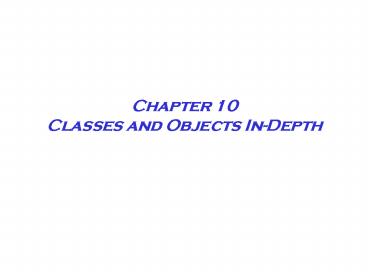Chapter 10 Classes and Objects In-Depth - PowerPoint PPT Presentation
Title:
Chapter 10 Classes and Objects In-Depth
Description:
A class provides the foundation for creating specific objects, each of which ... At the abstract level, a class can be described as an interface that defines the ... – PowerPoint PPT presentation
Number of Views:37
Avg rating:3.0/5.0
Title: Chapter 10 Classes and Objects In-Depth
1
Chapter 10Classes and Objects In-Depth
2
Chapter 10
- A class provides the foundation for creating
specific objects, each of which shares the
general attributes, or characteristics, and
behavior of the class. - At the abstract level, a class can be described
as an interface that defines the behavior of its
objects. - At the implementation level, a class is a
syntactical unit that describes a set of data and
related operations that are common to its
objects.
3
Chapter 10
- CLASS DECLARATION FORMAT
- class name
- //FUNCTION MEMBERS
- public
- Function prototypes go here.
- //DATA MEMBERS
- private
- Variable definitions go here.
- //END CLASS
4
Chapter 10
- The public class functions form the interface to
the class and are accessible from outside the
class. Public functions are used to provide
access to and manipulate the private class
members. A private class member is only
accessible within the class by functions of the
same class.
5
Chapter 10
- Encapsulation means to package data and/or
operations into a single well-defined programming
unit.
6
Chapter 10
- Information hiding means that there is a binding
relationship between the information, or data,
and its related operations so that operations
outside the encapsulated unit cannot affect the
information inside the unit.
7
Chapter 10
- The Unified Modeling Language, or UML, is a
technique for analyzing and designing
object-oriented software.
8
Chapter 10
- UML diagram for a SavingsAccount class
9
Chapter 10
- An object is an instance, or specimen, of a given
class. An object of a given class has the
structure and behavior defined by the class that
is common to all objects of the same class.
10
Chapter 10
- Object Definition Format
- class name object name
11
Chapter 10
- A function implementation is the definition of
the function that includes the function header
and the body of the function.
12
Chapter 10
- Format for a Function Implementation
- return type class name function name
(parameter listing) - //BODY OF FUNCTION GOES HERE
- //END FUNCTION
13
Chapter 10
- A constructor is a special class function that is
used to initialize an object automatically when
the object is defined.
14
Chapter 10
- Constructor Format
15
Chapter 10
- All the member functions of a class carry with
them an invisible pointer, called this, that
points to the object that called the function.
16
Chapter 10
- An access function, sometimes called a get
function, is a function that returns only the
values of the private members of an object.
17
Chapter 10
- A message is a call to a member function.
18
Chapter 10
- A type cast converts data of one type to a
different type, temporarily. You can convert data
of one type to another type by preceding the data
variable/expression with the type to convert to
within parentheses like this winPercent
(double)wins/(wins losses) 100
19
Chapter 10
- A project file identifies the files that need to
be compiled and linked to create a given
executable program.
20
Chapter 10
- A multi-file Project































